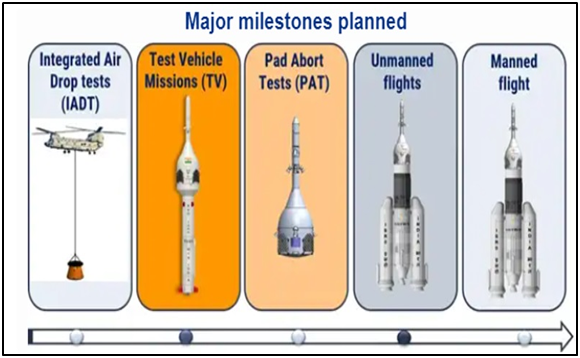PM Modi announces 4 astronauts for Gaganyaan
28-02-2024
10:17 AM
1 min read

What’s in today’s article?
- Why in news?
- What is Gaganyaan?
- News Summary: PM Modi announces 4 astronauts for Gaganyaan
- Current status of Gaganyaan missions

Why in news?
- PM Modi has announced the names of the four astronauts, who would fly to low-Earth orbit as part of ISRO’s Gaganyaan.
- The announcement came just days after ISRO said it had successfully tested the human readiness of the cryogenic engine.
- This engine will be used on the LVM3 vehicles for all of the Gaganyaan missions.
Gaganyaan
- Gaganyaan project envisages demonstration of human spaceflight capability by launching a crew of 3 members to an orbit of 400 km for a 3 days mission and bring them back safely to earth.
- It is part of the Indian Human Spaceflight Programme (IHSP), which was initiated (2007) by the ISRO to develop the technology needed to launch crewed orbital spacecraft into low earth orbit (LEO).
- Launch Vehicle Mark-3 (LVM3/GSLV Mk3) rocket - the well proven and reliable heavy lift launcher of ISRO, is identified as the launch vehicle for Gaganyaan mission.
- India’s heaviest rocket consists of solid stage, liquid stage and cryogenic stage.
- All systems in the LVM3 launch vehicle are re-configured to meet human rating requirements and christened Human Rated LVM3/HLVM3.
News Summary: PM Modi announces 4 astronauts for Gaganyaan
- PM Modi announced the names of the four astronauts, who would fly to low-Earth orbit as part of the ISRO’s Gaganyaan — the first crewed Indian space mission.
- The selected astronauts are:
- Prashanth Balakrishnan Nair, Angad Prathap, Ajit Krishnan, and Shubanshu Shukla.
- They are all either wing commanders or group captains with the Indian Air Force (IAF) and have extensive experience working as test pilots.
Current status of Gaganyaan missions
- The Gaganyaan missions include both manned and unmanned missions.
- The first unmanned Gaganyaan-1 mission, a test flight to check the technology readiness for the final mission, is scheduled to take off by the end of 2024.
- The manned mission, which will fly a three-membered crew into a low earth orbit at an altitude of 400 km for a period of three days, is scheduled later.
- Human rating of the launch vehicle
- ISRO will use its LVM3 rocket for all of the Gaganyaan missions.
- LVM3, earlier called GSLV-MkIII, is the space agency’s most powerful launch vehicle and has flown seven times and never failed.
- For the manned Gaganyaan mission, ISRO has reconfigured all the components of LVM3 to meet human rating requirements.
- Recently, in February 2024, the space agency performed final tests on the rocket’s cryogenic engine, known as CE20, which will power LVM3 during the cryogenic stage of the lift-off.
- The engine successfully passed and was certified for missions that would transport humans into space.
- The ‘Vikas’ engine to be used in the liquid stage and the solid booster, a part of the solid stage, have already qualified for the missions.
- ISRO will use its LVM3 rocket for all of the Gaganyaan missions.
- Development of crew module and crew escape system
- ISRO is also developing technology for the proposed human-space flight mission.
- These include:
- the development of life support systems to provide an earth-like environment to the crew in space,
- crew emergency escape provision, and
- evolving crew management aspects for training, recovery, and rehabilitation of crew.
- In October 2023, the space agency successfully conducted the first test of a basic crew module and crew escape system (CES).
- CES is a part of the module that ensures “the crew is taken to a safe distance in case of any emergency either at launch pad or during ascent phase.
- The next month, the space agency began to experiment with a crew module uprighting system.
- This system is used to ensure that the crew module, making a splashdown in the sea after a space mission, stays upright and does not get inverted in the water.
- Training of astronauts
- The four selected astronauts have completed their generic training at Russia’s Yuri Gagarin Cosmonaut Training Centre.
- Their training took place after ISRO-Glavkosmos (a subsidiary of Russian space agency Roscosmos) signed an MOU in June 2019.
- The astronauts are currently undergoing training at ISRO’s astronaut training facility in Bengaluru.
- One of the four astronauts is also expected to be trained by the American space agency NASA.
- The four selected astronauts have completed their generic training at Russia’s Yuri Gagarin Cosmonaut Training Centre.
Q1) What is Low Earth Orbit (LEO)?
Low Earth Orbit (LEO) is a region of Earth's orbit that is 2,000 kilometers (1,200 miles) or less from the Earth's surface. It's the closest orbital range to Earth, making it the easiest orbit to reach.
Q2) What is human rating of the launch vehicle?
Human-rating, also known as crew-rating or man-rating, is a process to certify a launch vehicle or spacecraft as able to transport humans safely.
Source: PM Modi announces 4 astronauts for Gaganyaan: Current status of the mission | ISRO |Indian Express


